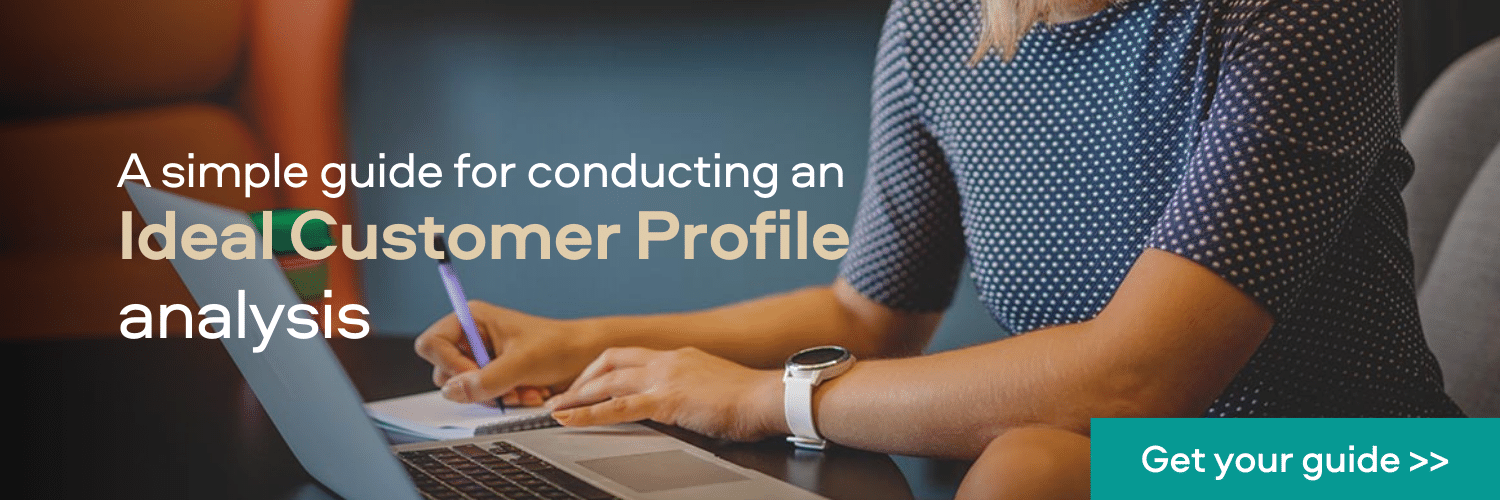Ideal Customer Profile: Practical Guide And A Template
Knowing you are focusing sales and marketing resources on the right companies isn’t all that easy, but one thing is certain: You can’t know if you haven’t defined a detailed an ideal customer profile. Doing so is among the most important things you can do to maximize the relevance of your marketing and the results of your sales efforts. It also helps you streamline your sales prospecting process as you know what type of companies to target. But first things first.
What is an ideal customer profile?
Essentially, it is a description of a fictitious account that gets significant value from your product or service and provides substantial value to your company in return. A company matching this description should be a potential customer that stays with you for a long time and has a strong lifetime value (LTV).
Introduction
According to HubSpot, 40 percent of all salespeople find prospecting the most challenging part of the sales process. No wonder there are studies that say this same activity takes up to half of your workday. Yeah, let that sink in … with a clearly defined Ideal Customer Profile, sales prospecting gets easier and more effective because you don’t have to evaluate every company one by one.
Rather, you simply know that a company is a solid opportunity to move forward with if it matches your Ideal Customer Profile.
Sales prospecting gets easier and more effective because you don’t have to evaluate every company one by one.
There are times when you should trust your gut and there are times when you would do wise in trusting data instead. Creating your Ideal Customer Profile certainly falls under this second category.
This article is the second chapter in our 60-page ultimate guide to sales prospecting. Here, we’ll tell you more about why having an Ideal Customer Profile is a must for all successful sales organizations and walk you through how to create a top-notch description of your dream customer.
Ideal customer profile and buyer persona: What’s the difference?
Simply put, your ideal customer profile is a description of the type of company you should try to sell to, whereas your buyer persona is a detailed analysis of the people who buy from you. Two sides of the same coin.
You need to have a deep understanding of both. An ideal customer profile will reveal the challenges, goals, and other characteristics of an account. But at the end of the day, you're selling to the humans within that account—the actual people in businesses who stand to benefit by using your product.
In this blog, we explain in more detail the differences between ideal customer profile and buyer persona.
Why do you need an ideal customer profile
Building a successful sales organization is not just about having your new business team close large deals. A detailed Ideal Customer Profile will help you maximize your sales and get satisfied customers that will stay with you for a long time, increasing their lifetime value (LTV). You can up-sell and cross-sell to them, and they can function as enthusiastic champions of your brand.
Don’t sell to someone who you believe will not be successful when using your product or service. While it may sound obvious, too often the immediate sell is just so very tempting that this rule of thumb is forgotten. A poorly satisfied customer takes a lot of time from your customer success team and might end up costing your company more than it pays.
An ideal customer profile helps you to:
- Streamline your sales prospecting as you know what companies to look for.
- Focus your sales and marketing efforts on the companies that are most likely to buy from you now.
- Sell to companies with the highest success potential of using your product or service. A customer that isn’t a good fit for your service drains time from your customer success team and may end up costing your company more than what could be gained from the partnership.
- Create smart short-lists of companies to focus on, track buying signals within these accounts, and act fast when a window of opportunity presents itself to you as a salesperson.
- Tailor your sales pitch better as you’ll have more information about why every company you reach out to is a good fit for your organization.
What makes a top-notch ideal customer profile
Basing your Ideal Customer Profile off of a gut feeling leaves a lot of room for error in judgment. Using insights from open data in understanding your Ideal Customer Profile will minimize the risk of missing many of the less obvious indicators of accounts that you and your team should ideally target.
Start looking at your current customers, specifically the most satisfied ones, and find their common characteristics and/or find a pattern of events at these companies that happened right before they signed a deal with you. By importing a list of your best customers into our sales intelligence platform Vainu, you can find out what they have in common and, as an example, see how many companies use HubSpot, have increased their revenue by more than 40 percent previous year or are frequently recruiting.
A blog post from McKinsey & Company includes a textbook example of why you shouldn’t only trust your gut when defining your Ideal Customer Profile. It tells the story of an IT services company that used big data analytics to predict which leads were most likely to close. The IT services firm found that established companies were better prospects than the start-ups it had been focusing on historically. Focusing its attention on established companies, the IT service company raised its overall lead-conversion rate by 30 percent.
Deciding which company features are most important for you to include in your Ideal Customer Profile depends a lot on what you're offering. For instance, if you’re selling a technical solution, a company’s tech stack could reveal a lot about how ready a company is to buy. Or if you’re selling transportation services, then you’d probably include buying signals: a company having won a large contract, for example.

How to create an ideal customer profile
1. Look at your happiest existing customers
What common attributes like revenue, number of employees, type of business, web technologies in use, or geography do your existing customers have? What happened (trigger events) at their end right before they signed a deal with you? Use the data Vainu and your other tools provide you with and have your customer success team conduct short interviews with your most satisfied customers. Ask them how they found your business, what made them choose to work with you, and why they continue to work with your company.
2. Prioritize customers that will stay with you
An unsatisfied customer takes a lot of time from your customer success team and might end up costing your company more than it pays. Find out what gives away a customer with great estimated lifetime value. Your customer success management system should have the data. What’s significant for the companies that you’ve been able to upsell and/or cross-sell to?
3. Find ready, willing, and able companies
No matter how great of a match your service is for a specific company, your ideal prospect also has to be ready, willing, and able to put ink on your contract.
An ideal customer should be ready to buy what you sell; the decision-makers have to understand that they have a problem or an opportunity and that you can help them solve it or seize it. An ideal customer should also be able to buy what you're selling. They have to have the money and support from the right decision-makers to give you a positive answer.
Ready? Here's an ideal customer profile template
Once you’ve defined your ideal customer profile, you should start looking at improving the way your sales, marketing, and development teams process companies matching this profile. Your ideal customer profile should dictate how you improve the product or service you offer, the wording your sales and marketing teams use towards prospects and customers, and how, when, and where you try to reach them.
Defining your ideal customer profile isn’t a one-time job. There’s no universal definition of an ideal customer profile, not for any company. Every six or nine months, you should evaluate if the company profile you’ve chosen as ideal still looks the same, or if you have to tweak the description.
To help you define and refine your ideal create profile, we've created a super simple template that you can download here.
